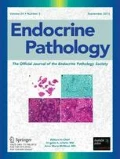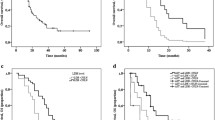Abstract
The gastrointestinal endocrine tumors are neoplastic lesions with often elusive malignant clinical behavior. The current WHO classification attempted to define a more effective approach by introducing the concepts of cell differentiation and site-specific malignancy, as well as specific criteria for carcinoma definition. WHO clinicopathological correlations embed the prognostic features: degree of cell differentiation, angioinvasion, proliferation fraction as assessed by mitotic index and Ki67, size, and functional activity. Other prognostic variables have been recognized, most of which related to specific biological features of neuroendocrine cancer cells. Nonetheless, the presence of liver or distant metastases are the prognostic variables ultimately determining the patients’ fate in terms of survival and/or therapy response. A recent proposal of tumor grading and tumor, nodes, and metastases (TNM) staging aims at a simple and practical system for patients stratification. Application of such proposal should be implemented in routine clinical practice.

Similar content being viewed by others
References
Hanahan D. Heritable formation of pancreatic beta-cell tumours in transgenic mice expressing recombinant insulin/simian virus 40 oncogenes. Nature 315:115–22, 1985.
Murphy D, Bishop A, Rindi G, Murphy MN, Stamp GW, Hanson J, et al. Mice transgenic for a vasopressin-SV40 hybrid oncogene develop tumors of the endocrine pancreas and the anterior pituitary. A possible model for human multiple endocrine neoplasia type 1. Am J Pathol 129:552–66, 1987.
Efrat S, Teitelman G, Anwar M, Ruggiero D, Hanahan D. Glucagon gene regulatory region directs oncoprotein expression to neurons and pancreatic alpha cells. Neuron 1:605–13, 1988.
Rindi G, Bishop AE, Murphy D, Solcia E, Hogan B, Polak JM. A morphological analysis endocrine tumour genesis in pancreas and anterior pituitary of AVP/SV40 transgenic mice. Virchows Arch A Pathol Anat Histopathol 412:255–66, 1988.
Rindi G, Grant SG, Yiangou Y, Ghatei MA, Bloom SR, Bautch VL, et al. Development of neuroendocrine tumors in the gastrointestinal tract of transgenic mice. Heterogeneity of hormone expression. Am J Pathol 136:1349–63, 1990.
Rindi G, Efrat S, Ghatei MA, Bloom SR, Solcia E, Polak JM. Glucagonomas of transgenic mice express a wide range of general neuroendocrine markers and bioactive peptides. Virchows Arch A Pathol Anat Histopathol 419:115–29, 1991.
Rindi G, Ratineau C, Ronco A, Candusso ME, Tsai M, Leiter AB. Targeted ablation of secretin-producing cells in transgenic mice reveals a common differentiation pathway with multiple enteroendocrine cell lineages in the small intestine. Development 126:4149–56, 1999.
Crabtree JS, Scacheri PC, Ward JM, Garrett-Beal L, Emmert-Buck MR, Edgemon KA, et al. A mouse model of multiple endocrine neoplasia, type 1, develops multiple endocrine tumors. Proc Natl Acad Sci USA 98:1118–23, 2001.
Crabtree JS, Scacheri PC, Ward JM, McNally SR, Swain GP, Montagna C, et al. Of mice and MEN1: insulinomas in a conditional mouse knockout. Mol Cell Biol 23:6075–85, 2003.
Bertolino P, Tong WM, Galendo D, Wang ZQ, Zhang CX. Heterozygous Men1 mutant mice develop a range of endocrine tumors mimicking multiple endocrine neoplasia type 1. Mol Endocrinol 17:1880–92, 2003.
Biondi CA, Gartside MG, Waring P, Loffler KA, Stark MS, Magnuson MA, et al. Conditional inactivation of the MEN1 gene leads to pancreatic and pituitary tumorigenesis but does not affect normal development of these tissues. Mol Cell Biol 24:3125–31, 2004.
Pellegata NS, Quintanilla-Martinez L, Siggelkow H, Samson E, Bink K, Hofler H, et al. Germ-line mutations in p27Kip1 cause a multiple endocrine neoplasia syndrome in rats and humans. Proc Natl Acad Sci USA 103:15558–63, 2006.
Solcia E, Capella C, Fiocca R, Rindi G, Rosai J. Gastric argyrophil carcinoidosis in patients with Zollinger-Ellison syndrome due to type 1 multiple endocrine neoplasia. A newly recognized association. Am J Surg Pathol 14:503–13, 1990.
Vortmeyer AO, Huang S, Lubensky I, Zhuang Z. Non-islet origin of pancreatic islet cell tumors. J Clin Endocrinol Metab 89:1934–8, 2004.
Anlauf M, Perren A, Henopp T, Rudolph T, Garbrecht N, Schmitt A, et al. Allelic deletion of the MEN1 gene in duodenal gastrin and somatostatin cell neoplasms and their precursor lesions. Gut 56:637–44, 2006.
Anlauf M, Schlenger R, Perren A, Bauersfeld J, Koch CA, Dralle H, et al. Microadenomatosis of the endocrine pancreas in patients with and without the multiple endocrine neoplasia type 1 syndrome. Am J Surg Pathol 30:560–74, 2006.
Perren A, Anlauf M, Henopp T, Rudolph T, Schmitt A, Raffel A, et al. Multiple endocrine neoplasia type 1 (MEN1): loss of one MEN1 allele in tumors and monohormonal endocrine cell clusters but not in islet hyperplasia of the pancreas. J Clin Endocrinol Metab 92:1118–28, 2007.
Rindi G, Leiter AB, Kopin AS, Bordi C, Solcia E. The “normal” endocrine cell of the gut: changing concepts and new evidences. Ann N Y Acad Sci 1014:1–12, 2004.
Lloyd RV, Wilson BS. Specific endocrine tissue marker defined by a monoclonal antibody. Science 222:628–30, 1983.
Wiedenmann B, Franke WW. Identification and localization of synaptophysin, an integral membrane glycoprotein of Mr 38,000 characteristic of presynaptic vesicles. Cell 41:1017–28, 1985.
Bishop AE, Polak JM, Facer P, Ferri GL, Marangos PJ, Pearse AG. Neuron specific enolase: a common marker for the endocrine cells and innervation of the gut and pancreas. Gastroenterology 83:902–15, 1982.
Thompson RJ, Doran JF, Jackson P, Dhillon AP, Rode J. PGP9.5 a new marker for vertebrate neurons and neuroendocrine differentiation. Brain Res 278:224–8, 1983.
Lantuejoul S, Moro D, Michalides RJ, Brambilla C, Brambilla E. Neural cell adhesion molecules (NCAM) and NCAM-PSA expression in neuroendocrine lung tumors. Am J Surg Pathol 22:1267–76, 1998.
Solcia E, Klöppel G, Sobin LH. Histological typing of endocrine tumours. New York: Springer-Verlag, 2000.
Hamilton SR, Aaltonen LA. World Health Organization classification of tumours, pathology and genetics of tumours of the digestive system. Lyon: IARC Press, 2000.
DeLellis RA, Lloyd RV, Heitz PU, Eng C. World Health Organization classification of tumours, pathology and genetics of tumours of endocrine organs. Lyon: IARC Press, 2004.
Rigaud G, Missiaglia E, Moore PS, Zamboni G, Falconi M, Talamini G, et al. High resolution allelotype of nonfunctional pancreatic endocrine tumors: identification of two molecular subgroups with clinical implications. Cancer Res 61:285–92, 2001.
Zhao JM, Moch H, Scheidweiler AF, Baer A, Schaffer AA, Speel EJM, et al. Genomic imbalances in the progression of endocrine pancreatic tumors. Genes Chromosomes Cancer 32:364–72, 2001.
Jonkers YM, Claessen SM, Perren A, Schmid S, Komminoth P, Verhofstad AA, et al. Chromosomal instability predicts metastatic disease in patients with insulinomas. Endocr-Relat Cancer 12:435–47, 2005.
Floridia G, Grilli G, Salvatore M, Pescucci C, Moore PS, Scarpa A, et al. Chromosomal alterations detected by comparative genomic hybridization in nonfunctioning endocrine pancreatic tumors. Cancer Genet Cytogenet 156:23–30, 2005.
Pizzi S, Azzoni C, Bassi D, Bottarelli L, Milione M, Bordi C. Genetic alterations in poorly differentiated endocrine carcinomas of the gastrointestinal tract. Cancer 98:1273–82, 2003.
Furlan D, Cerutti R, Uccella S, La Rosa S, Rigoli E, Genasetti A, et al. Different molecular profiles characterize well-differentiated endocrine tumors and poorly differentiated endocrine carcinomas of the gastroenteropancreatic tract. Clin Cancer Res 10:947–57, 2004.
Rindi G, Azzoni C, La Rosa S, Klersy C, Paolotti D, Rappel S, et al. ECL cell tumor and poorly differentiated endocrine carcinoma of the stomach: prognostic evaluation by pathological analysis. Gastroenterology 116:532–42, 1999.
Artale S, Giannetta L, Cerea G, Pedrazzoli P, Schiavetto I, Napolitano M, et al. Treatment of metastatic neuroendocrine carcinomas based on WHO classification. Anticancer Res 25:4463–9, 2005.
Bajetta E, Catena L, Procopio G, Bichisao E, Ferrari L, Della Torre S, et al. Is the new WHO classification of neuroendocrine tumours useful for selecting an appropriate treatment? Ann Oncol 16:1374–80, 2005.
Panzuto F, Nasoni S, Falconi M, Corleto VD, Capurso G, Cassetta S, et al. Prognostic factors and survival in endocrine tumor patients: comparison between gastrointestinal and pancreatic localization. Endocr-Relat Cancer 12:1083–92, 2005.
Ruszniewski P, Ish-Shalom S, Wymenga M, O’Toole D, Arnold R, Tomassetti P, et al. Rapid and sustained relief from the symptoms of carcinoid syndrome: results from an open 6-month study of the 28-day prolonged-release formulation of lanreotide. Neuroendocrinology 80:244–51, 2004.
Tomassetti P, Campana D, Piscitelli L, Casadei R, Nori F, Brocchi E, et al. Endocrine tumors of the ileum: factors correlated with survival. Neuroendocrinology 83:380–6, 2006.
D’Adda T, Candidus S, Denk H, Bordi C, Hofler H. Gastric neuroendocrine neoplasms: tumour clonality and malignancy-associated large X-chromosomal deletions. J Pathol 189:394–401, 1999.
Pizzi S, D’Adda T, Azzoni C, Rindi G, Grigolato P, Pasquali C, et al. Malignancy-associated allelic losses on the X-chromosome in foregut but not in midgut endocrine tumours. J Pathol 196:401–7, 2002.
Missiaglia E, Moore PS, Williamson J, Lemoine NR, Falconi M, Zamboni G, et al. Sex chromosome anomalies in pancreatic endocrine tumors. Int J Cancer 98:532–8, 2002.
Chen YJ, Vortmeyer A, Zhuang Z, Gibril F, Jensen RT. X-chromosome loss of heterozygosity frequently occurs in gastrinomas and is correlated with aggressive tumor growth. Cancer 100:1379–87, 2004.
Couvelard A, Hu J, Steers G, O’Toole D, Sauvanet A, Belghiti J, et al. Identification of potential therapeutic targets by gene-expression profiling in pancreatic endocrine tumors. Gastroenterology 131:1597–610, 2006.
Roldo C, Missiaglia E, Hagan JP, Falconi M, Capelli P, Bersani S, et al. MicroRNA expression abnormalities in pancreatic endocrine and acinar tumors are associated with distinctive pathologic features and clinical behavior. J Clin Oncol 24:4677–84, 2006.
Butturini G, Bettini R, Missiaglia E, Mantovani W, Dalai I, Capelli P, et al. Predictive factors of efficacy of the somatostatin analogue octreotide as first line therapy for advanced pancreatic endocrine carcinoma. Endocr-Relat Cancer 13:1213–21, 2006.
Hochwald SN, Zee S, Conlon KC, Colleoni R, Louie O, Brennan MF, et al. Prognostic factors in pancreatic endocrine neoplasms: an analysis of 136 cases with a proposal for low-grade and intermediate-grade groups. J Clin Oncol 20:2633–42, 2002.
Van Eeden S, Quaedvlieg PF, Taal BG, Offerhaus GJ, Lamers CB, Van Velthuysen ML. Classification of low-grade neuroendocrine tumors of midgut and unknown origin. Hum Pathol 33:1126–32, 2002.
Rindi G, Klöppel G, Ahlman H, Caplin M, Couvelard A, de Herder WW, et al. TNM staging of foregut (neuro)endocrine tumors: a consensus proposal including a grading system. Virchows Arch 449:395–401, 2006.
Rindi G, de Herder WW, O’Toole D, Wiedenmann B. Consensus guidelines for the management of patients with digestive neuroendocrine tumors: why such guidelines and how we went about It. Neuroendocrinology 84:155–7, 2006.
Panzuto F, Di Fonzo M, Iannicelli E, Sciuto R, Maini CL, Capurso G, et al. Long-term clinical outcome of somatostatin analogues for treatment of progressive, metastatic, well-differentiated entero-pancreatic endocrine carcinoma. Ann Oncol 17:461–6, 2006.
Rossi G, Valli R, Bertolini F, Sighinolfi P, Losi L, Cavazza A, et al. Does mesoappendix infiltration predict a worse prognosis in incidental neuroendocrine tumors of the appendix? A clinicopathologic and immunohistochemical study of 15 cases. Am J Clin Pathol 120:706–11, 2003.
Stinner B, Rothmund M. Neuroendocrine tumours (carcinoids) of the appendix. Best Pract Res Clin Gastroenterol 19:729–38, 2005.
Koura AN, Giacco GG, Curley SA, Skibber JM, Feig BW, Ellis LM. Carcinoid tumors of the rectum: effect of size, histopathology, and surgical treatment on metastasis free survival. Cancer 79:1294–8, 1997.
Schindl M, Niederle B, Hafner M, Teleky B, Langle F, Kaserer K, et al. Stage-dependent therapy of rectal carcinoid tumors. World J Surg 22:628–33; discussion 634, 1998.
Fahy BN, Tang LH, Klimstra D, Wong WD, Guillem JG, Paty PB, et al. Carcinoid of the Rectum Risk Stratification (CaRRS): a strategy for preoperative outcome assessment. Ann Surg Oncol 14:396–404, 2007.
Acknowledgment
Source of support: grants from MURST (COFIN 05) and the University of Parma (FIL 05).
Author information
Authors and Affiliations
Corresponding author
Rights and permissions
About this article
Cite this article
Rindi, G., D’Adda, T., Froio, E. et al. Prognostic Factors in Gastrointestinal Endocrine Tumors. Endocr Pathol 18, 145–149 (2007). https://doi.org/10.1007/s12022-007-0020-x
Published:
Issue Date:
DOI: https://doi.org/10.1007/s12022-007-0020-x




